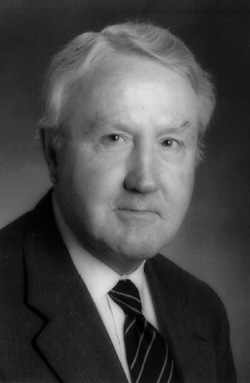
George Forsyth
Reorganization set to bolster VUMC's financial oversight
Numerous changes are taking place in the department responsible for balancing Vanderbilt University Medical Center's checkbook.
After 23 years of sterling leadership, George Forsyth has retired from his position as chief financial officer of VUMC; the Department of Financial Management has been renamed the Department of Finance; and, following an extensive analysis, certain financial functions currently embedded in other operational areas of VUMC will be transferred to the Department of Finance.
"Throughout his years of service, George dedicated himself to ensuring the financial success of the medical center," said Dr. Harry R. Jacobson, vice chancellor for Health Affairs. "Through his good efforts, the medical center today finds itself on solid financial footing. He has truly been a most important asset."
Rick Wagers, vice president of Finance, will serve as interim CFO.
In conjunction with VUMC's goal to become a truly premier medical center, international business consulting form KPMG was retained to analyze the institution's current financial organization and to recommend any changes necessary to optimize its performance. After extensive interviews and analysis, KPMG created a set of recommendations, which they discussed with a steering committee, the members of which created the final plan.
To demonstrate the organizational change and corporate emphasis, the plan recommended renaming Financial Management as the Department of Finance.
The primary goal of the recommendations was to create a strong corporate financial function for the medical center, which requires that certain financial functions currently embedded in other operational areas be transferred to the Department of Finance. While the line officers remain responsible for the operations in their areas, financial policies and procedures will be the responsibility of the Department of Finance. Therefore:
o the financial director of each of the operating enterprises will report directly to the corporate financial office;
o the Department of Finance will be responsible for corporate financial functions that were housed in operating management areas;
o matrixed reporting responsibilities will be created for the line officers in the operating areas.
Examples of some of the responsibilities which will be transferred from operational areas to the Department of Finance include Medical and Nursing School budget coordination; Medical and Nursing School financial policies and procedures; and VMG business office billing and collections.
Examples of some of the responsibilities which will not be transferred from operational areas to the Department of Finance include centralized campus financial functions such as accounts payable, and operational financial responsibilities of the Medical School business officers.
While the day-to-day responsibilities and reporting of departmental business officers will not change, the Department of Finance will be responsible for coordination of financial communication and direction. Thus, communication regarding corporate financial policies and procedures should flow directly from the Department of Finance to the business officers.
The structure is focused on supporting four enterprises within the medical center – academic and research, Vanderbilt University Hospital, Vanderbilt Medical Group and enterprise-wide functions.
Academic and Research
The medical center's strategic plan requires more emphasis on the academic and research areas. The KPMG plan, therefore, recommends organizational changes to the current VUSM, VUSN and Medical Center Other (MCO) financial structure.
Medical School and Nursing School corporate financial functions, such as budgeting, forecasting, analysis and policy development, will report within the Academic and Research section of the Department of Finance's structure. Currently, these responsibilities are divided between the Schools and the Department of Finance. Financial processes will be directed from the Department of Finance, rather than from the respective School administrations. Centralizing these functions entirely within the Department of Finance allows the Medical and Nursing Schools to focus on operational issues. A new director position has been created to coordinate these additional responsibilities within the Department of Finance.
Hospital
The plan calls for a significant interaction between the VMG and VUH finance directors and staff. The Patient Care Center structure was originally created to provide continuity between inpatient and outpatient clinical areas. Thus, the VMG and VUH financial directors will work closely to provide continuity in financial planning, budgeting, and overall financial direction for the hospital and clinic, VMG, and the Patient Care Centers. The Patient Care Center financial managers will interact and receive direction in their day-to-day work from both the VMG financial director and the Hospital financial director. However, direct reporting of the Patient Care financial managers will remain to the VUH finance director.
VMG
The VMG director of Finance position was created in 1998 in order to strengthen the VMG financial function and was endorsed in the recommended plan. The reporting of the VMG billing office through the VMG director of Finance in the Department of Finance allows for strong corporate oversight of this important financial function. The initial focus of this position is improving the physician practice billing process to maximize revenue capture. In addition, the VMG director of Finance will coordinate reporting and financial analysis for the Vanderbilt Clinic and off-campus practices.
Enterprise-wide Functions
The plan recommends a corporate-level coordination function of all subsidiary and joint-venture financial activities as well as a consolidation of all financial infrastructure tasks for the overall enterprise. Enterprise-wide functions will encompass the financial coordination of subsidiaries and joint ventures along with enterprise-wide support functions such as Medical Payroll, Demand Check, Travel, GL Control, MCO (Medical Center Other) and OAM (Other Auxiliaries Medical).
"In summary, the reorganization plan provides for a strong, centralized financial function, with corporate financial functions directed through the Department of Finance," Jacobson said. "The intent of these changes is to provide a single conduit through which financial activities and reporting can be directed within the medical center and a smoother coordination of financial activities throughout the medical center."













